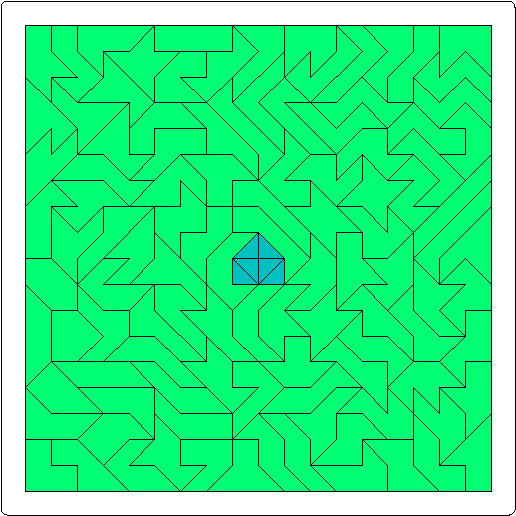One of the more complex of the polyform genre is the series of shapes made by joining isosceles right triangles along their matching edges in every possible combination. The family name of this set is polytans, borrowing the word tan from the classic Tangram set. Sometimes mathematicians also refer to polytans as polyaboloes.
From chapter 11, "Polyhexes and Polyaboloes," of Martin Gardner's Mathematical Magic Show:
This family of pieces was first discussed in print by Thomas H. O'Beirne in New Scientist, December 21, 1961, in a column on recreational mathematics that he then contributed regularly to the magazine. The pieces had been suggested to him by S. J. Collins of Bristol, England, who gave the name "tetraboloes" to the order-4 set because the diabolo, a juggling toy, has two isosceles right triangles in its cross section. This implies the generic name "polyaboloes."
While the word "diabolo" has some dictionary associations with "devil," in this case the word is rooted in the Greek for "across" (dia-, as in diameter or diagonal) and "throwing" (ballo). Thus it has more kinship with the gauchos' balo or bolo than with anything diabolical. Calling the puzzle set polytans eliminates the confusion.
Since each unit triangle is half a square (a square cut in half diagonally), the pieces always want to reunite the two halves to form squares again. It takes a little practice to recognize the tile edge that is the hypotenuse, which must be oriented diagonally for the tile to fit properly within its grid.
We offer the series from 1 through 6 in three separate, progressively larger square trays. The smallest contains sizes 1, 2 and 4. The middle size holds sizes 3 and 5. The largest has all the tiles of size 6. Each size is given its own color for easy sorting. We use beautifully tinted transparent acrylic, precision lasercut. The sizes are, of course, all compatible for mixing and matching in larger figures. A large workbook includes challenges for the whole series.
The various sizes have their own names as well, with the prefix indicating how many triangles the piece contains: unit, ditan, tritan, tetratan, pentatan and hexatan.
That the sizes 1 through 5 would divide so neatly into two squares was discovered by Michael Keller of Baltimore.



